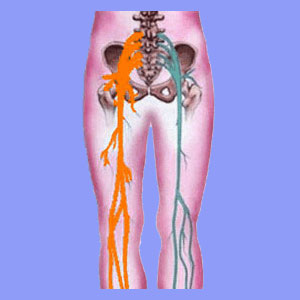
Left side sciatica is one of the possible symptomatic locations of unilateral sciatica pain. Most sciatica patients suffer nerve pain on one side or the other, while only a small number are afflicted with bilateral sciatica. Typically the same causes can be equally responsible for pain on the left, as well as right side sciatica.
Unlike symptoms which occur in the torso, there are no particular reasons why a person would suffer pain on the left, compared to the right. The spinal anatomy is perfectly symmetrical and pain may occur on either side, depending on the area affected by an injury or degenerative process.
This article details sciatica symptoms which exist only on the left of the body. These symptoms may occur throughout the left side, in the buttocks, leg and foot or may be limited to just one area of the left side anatomy.
Left Side Sciatica Causes
Unilateral sciatica on the left side of the lower body can be enacted by a great number of possible reasons. Most patients are likely to be diagnosed with a theorized or actual spinal causation, such as a herniated disc, osteoarthritis, scoliosis or spondylolisthesis causing pain by impinging on the spinal cord or one or more of the spinal nerve roots.
Other patients will be judged to suffer from pseudo-sciatica pain from a non-spinal problem, such as sacroiliac joint issues or piriformis syndrome.
Most patients will suffer a variable pain pattern, including widespread pain, tingling, numbness and weakness in the left lower back, left leg and/or left foot.
It is crucial to know that in order for the structural issue to cause pain on the left only, the source process will have to influence a nerve tissue on the left side. In cases of a pinched nerve, regardless of the cause, this nerve root would have to be on the left of the spinal canal. However, in central spinal stenosis cases, symptoms are often more difficult to correlate. These symptoms might exist bilaterally or unilaterally, and may even change in location, expression or side often.
Sciatica Only on the Left Side
In order to enjoy lasting relief from unilateral left sided sciatic nerve symptoms, it is vital that an accurate diagnosis be in place. While this seems like the easy part of the treatment process, it is actually the most convoluted and complicated.
The fact that so many sciatica treatments fail backs up the simple truth that so many patients are incorrectly diagnosed from the beginning. Any logical mind will conclude that therapies which fail time and time again are probably not targeting the actual source of pain. In essence, they are misdirected and unnecessary, when all the while, the real source of pain goes completely untreated. This happens all the time.
If you want to read a truly terrible tale of decades of misdiagnosis, then be sure to read my own sciatica story. Judging by the feedback you send to me on the site, I know my nightmarish experiences also mirror your own to a large degree.
Left Side Sciatica Experiences
Regardless of why you suffer with enduring sciatica in your left leg or foot, it is important to keep several important considerations in your mind at all times:
Relying exclusively on sciatica drugs, or using any other form of purely symptomatic treatment, will never provide a lasting answer for your pain. You must discover the underlying cause of the pain and address that issue using a curative modality to resolve it permanently. Anything else is simply putting a bandage on the problem to cover it up and hope for the best.
Do not follow healthcare recommendations without question, but instead, get actively involved in your own care. Be responsible. It is your life. Your health. Research your diagnosis, symptoms and therapy options, then use this information to work with your physicians to solve the pain puzzle together.
Always remember that sciatica surgery is likely to be prescribed at some point for chronic conditions. This does not mean that it is necessary in many cases or that it will work. In fact, many postoperative patients suffer a dramatic downward spiral of health after a spinal operation. Be very careful.
Always seek more than two diagnostic opinions and be sure to include a consultation with a non-surgeon to make sure that money is not the main motivation for a surgical recommendation.





